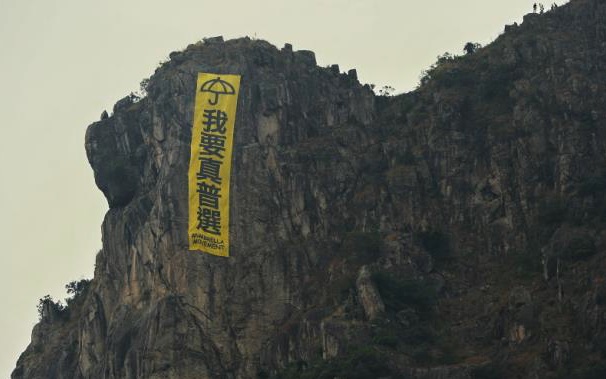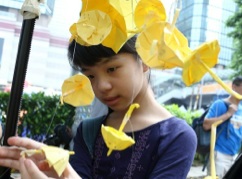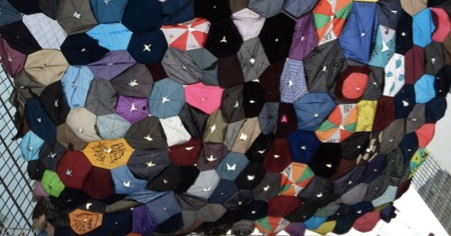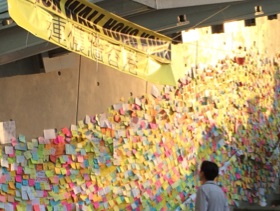藝術議題
- 傘運創意最新的專題文章如下。如欲閱讀有關同一議題的其他文章,可再點擊右下角資料庫的年份和月份。
The Blossoming of an All-pervasive Creativity in the City
何慶基 (Oscar HO)
at 0:00am on 20th December 2014




(原文以英文發表,題為「城市處處綻放無窮的創造力」。)
The tenacity, wisdom and perseverance in the pursuit of dream evinced by the citizens of Hong Kong throughout the Umbrella Movement have attracted worldwide attention. Even more impressive is the intense burst of creativity during the movement, which is unprecedented in Hong Kong and provides us with an entirely new definition of political and community art. The only historical moment comparable to this was the student movement in 1989, during which a good number of citizens made use of slogans and posters to express their fury and sadness. However, compared to the exclusively damning indictments back then, what is happening now is evidently much more diversified and complex. What merits our attention is not the artworks from professional artists, but the street political art coming from the public, in which sincerity, mockery, versatility and diversity abound. It not only consists of collaborative efforts, but also retains a democratic space for individual expression, laying bare the spirit of this movement and the uniqueness of Hong Kong culture. Indeed, to appreciate the distinctiveness which is nowhere seen but in Hong Kong, one simply needs to turn to the example of singing of the happy birthday song as a nonsensical but effective way of coping with the abuse hurled at the movement participants.
The whole city has displayed a collaborative artistic creation rarely seen in the modern history of social movement. Making full use of various forms of artistic expression such as signs, images, rituals, music, dance and even bodily movements as a vehicle, the people have turned Hong Kong into a colourful artwork consisting of murals, posters, slogans, banners, graffiti found everywhere on the street, as well as the waving yellow paper umbrellas underneath the footbridge. And let's not forget the projections on the buildings, t-shirts, slogans and fake tattoos on the body, countless images and texts on the umbrellas, as well as all sorts of musical works, images, and animations published on the internet. Do we still need West Kowloon to build a creative city? Hong Kong has already proved to be a region with an originality that knows no limits.
To give birth to this as yet unequalled creativity, certain conditions need to be fulfilled, the most important of which is lending an impetus for creation. Because of the pursuit of democracy and freedom, the anger directed at the disgraceful corporations, and the revulsion towards the unequal distribution of wealth and political power, the people just can't help but yield to their impulse of expression, which surges up massively and breaks free at the critical point. This profusion of sentiments is the principal driving force behind political art. The reason why the anti-occupy people have failed to come up with some out-of-the-box artistic ideas is that they are not even sure what they are opposing, and are no more than some temporary workers paid to shout the slogans. How can we expect that they could genuinely express their cause loud and clear?
Many of the artworks inspired by the movement have been spontaneously created by the general public. To begin with, a handful of the people voiced their opinions and created a platform for expression, and though they might not have something called "art" in mind, the outcome did consist of vivid images and strong messages that integrated history with art and often became admirably moving. What was involved includes the expression of individual creativity, sentiment and idea, and it really makes no difference whether it is called "art". The "Lennon Wall", in this regard, serves as the most illustrative example. The Wall is situated at the Government Headquarters, a place of centralized power, and thus it denotes the determination of the people to claim back the space tied to their own fate. Opposite the wall, one sees a line from "Imagine", an all-time favorite song by John Lennon - "You may say I'm a dreamer, but I'm not the only one". It is about the pursuit of a dream shared among the people and going forward together despite difficulties, which is also in line with the tradition of social movement struggling for the rights of the people in the last century. Everyone writes or draws on the countless tiny colourful stickers, and the indictment, wish and hope from everyone expands like boundless waves. The "Lennon Wall", which is still growing, not only respects individual expression, but also puts together collective efforts, reflecting precisely the distinctive qualities of this movement.
Another exceptional work is the making of small yellow paper umbrellas, an event initiated by a few high school students. The cost of paper is low but the umbrellas need to be handmade, thus engendering a special sense of intimacy. The site of production is flexible, as one may make them at the occupy area, at school or at home. A collective production can turn the work into a huge installation, whose different parts disperse here and there in various forms and with different combinations: underneath the footbridge, on the road, or fastened to clothes. One evening, seeing how the series of bright yellow tiny umbrellas underneath the footbridge of Admiralty waved gently against the backdrop of darkness in the city, I realized that politics can in fact feel so tender.
The umbrellas damaged by the police and hung between two bridges in Admiralty were re-sewed into a big umbrella by students from Hong Kong Baptist University. By merging things damaged by violence, the students transformed them into an even more spectacular umbrella with a still larger covered area, showcasing the endurance and energy that never runs out and can never be torn asunder.
The banner with the slogan of "I want real universal suffrage" hung from the highest point of Lion Rock all at once by "the Hong Kong Spiders" introduced an exhilarating surprise into the Umbrella Movement, at a time when it appeared to be losing momentum. To put up a huge banner on the steep peak requires extraordinary skills and abilities not possessed by an average person. And what is remarkable is the fact that this production of a huge banner with an appropriate scale and a pronounced presentation is a private production. The smart use of the symbol of Lion Rock served as a timely response to the discriminatory speech against the poor delivered by CY Leung. The symbol of Lion Rock, which refers to poverty but also tenacity and perseverance, stands proudly as a stark contrast to the Peak, where the rich live. By making use of the geographical, historical and cultural significance stemming from the local place to introduce a central meaning into the artwork, it is truly a public art par excellence. The basic contradiction behind the Umbrella Movement has been fully embodied in a banner and two big hills.
Precisely because of the deep reverberations arising from the banner, the Government wasted no time to remove it. But in this age of information, once the magnificent image has been captured, it spreads like wildfire and stays forever, which is why the desperate resort to the helicopter to get rid of it is destined to be in vain. There is no doubt that, from now on, Hong Kong people will look at Lion Rock differently.
The ever-expanding vitality of community art entails not only creativity, but also the support of the people. Since 1997, the Government has time and again borrowed the image of Lion Rock as a subtle way to attract publicity, but their attempt is hardly on a par with this simple banner. This shows that, only when a banner reaches the deepest feelings and longings of the people can it make an impact in the form of a dialogue. Otherwise, it becomes no more than a mere futile ornament of political propaganda that can do nothing more than frittering away money.
More important, Lion Rock has redrawn the boundary of the movement to include places outside the occupy area as well, setting the scene for progressing to the second "all-pervasive" stage. Indeed, after the banner had been violently removed, it blossomed everywhere: on the bare hillsides, at school, on the windows of residential buildings, on the street, you name it. Now that the ‘occupied zones’ are cleared, but the passion and determination for universal suffrage would go one, for the Lion Rock banner has already made an official announcement of the further expansion of the Umbrella Movement.
In possession of techniques, visual effects, contents, symbolic meanings and, even more, the people's participation and vitality essential to political art, the Umbrella Movement has given rise to an unparalleled collective creativity and it will continue to blossom. The impetus behind this creativity: the calls for democracy, freedom and justice, can never be stifled by any kind of brutality.
